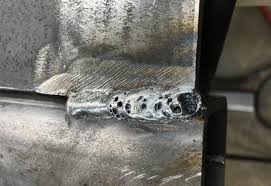What is Porosity in Welding: Crucial Tips for Getting Flawless Welds
What is Porosity in Welding: Crucial Tips for Getting Flawless Welds
Blog Article
The Scientific Research Behind Porosity: A Comprehensive Overview for Welders and Fabricators
Comprehending the intricate systems behind porosity in welding is important for welders and makers striving for impressive craftsmanship. From the structure of the base products to the complexities of the welding process itself, a wide range of variables conspire to either worsen or relieve the visibility of porosity.
Comprehending Porosity in Welding
FIRST SENTENCE:
Evaluation of porosity in welding reveals important understandings into the stability and quality of the weld joint. Porosity, identified by the visibility of dental caries or voids within the weld steel, is a common issue in welding procedures. These spaces, otherwise correctly resolved, can jeopardize the architectural stability and mechanical homes of the weld, resulting in potential failings in the finished item.

To find and measure porosity, non-destructive screening approaches such as ultrasonic screening or X-ray evaluation are typically employed. These techniques enable the recognition of interior defects without jeopardizing the integrity of the weld. By assessing the size, shape, and circulation of porosity within a weld, welders can make educated decisions to boost their welding processes and accomplish sounder weld joints.

Elements Affecting Porosity Formation
The occurrence of porosity in welding is affected by a myriad of elements, ranging from gas protecting efficiency to the ins and outs of welding parameter setups. One critical factor adding to porosity development is insufficient gas protecting. When the protecting gas, generally argon or carbon dioxide, is not successfully covering the weld pool, climatic gases like oxygen and nitrogen can infect the liquified metal, causing porosity. Furthermore, the cleanliness of the base materials plays a significant duty. Impurities such as rust, oil, or moisture can evaporate during welding, producing gas pockets within the weld. Welding parameters, consisting of voltage, current, take a trip speed, and electrode kind, also impact porosity formation. Making use of incorrect settings can create extreme spatter or heat input, which in turn can result in porosity. Additionally, the welding strategy used, such as gas metal arc welding (GMAW) or shielded steel arc welding (SMAW), can affect porosity formation due to variations in warmth distribution and gas insurance coverage. Recognizing and managing these variables are vital for reducing porosity in welding procedures.
Effects of Porosity on Weld High Quality
The existence of porosity likewise deteriorates the weld's resistance to rust, as the trapped air or gases within the voids can react with the surrounding atmosphere, leading to my site degradation over time. Furthermore, porosity can impede the weld's capability to endure stress or impact, further jeopardizing the general top quality and integrity of the bonded framework. In critical applications such as aerospace, automobile, or architectural constructions, where security and resilience are extremely important, the harmful effects of porosity on weld quality can have serious repercussions, stressing the importance of decreasing porosity with correct welding methods and treatments.
Techniques to Lessen Porosity
Furthermore, making use of the suitable welding specifications, such as the appropriate voltage, present, and take a trip speed, is crucial in stopping porosity. Maintaining a consistent arc length and angle throughout welding likewise helps lower the probability of porosity.

Making use of the proper welding strategy, such as back-stepping or employing a weaving motion, can also help distribute warmth uniformly and minimize the chances of porosity development. By applying these techniques, welders can effectively reduce porosity and create premium welded joints.

Advanced Solutions for Porosity Control
Executing advanced innovations and innovative methods plays a crucial duty in accomplishing remarkable control over porosity in welding processes. Additionally, using innovative welding strategies such as pulsed MIG welding or modified atmosphere welding can additionally assist alleviate porosity problems.
Another sophisticated solution includes making use of innovative welding equipment. Making use of tools with integrated functions like waveform control and advanced power have a peek at these guys resources can enhance weld high quality and reduce porosity threats. In addition, the execution of automated welding systems with precise control over parameters can significantly lessen porosity problems.
Moreover, incorporating advanced surveillance and examination modern technologies such as real-time X-ray imaging or automated ultrasonic testing can aid in finding porosity early in the welding procedure, permitting for instant restorative actions. On the whole, integrating these innovative services can significantly enhance porosity control and enhance the linked here general high quality of welded parts.
Final Thought
Finally, recognizing the scientific research behind porosity in welding is crucial for welders and makers to generate premium welds. By identifying the factors influencing porosity formation and applying methods to reduce it, welders can boost the general weld top quality. Advanced services for porosity control can better improve the welding process and guarantee a strong and dependable weld. It is very important for welders to constantly educate themselves on porosity and carry out best techniques to accomplish optimal outcomes.
Report this page